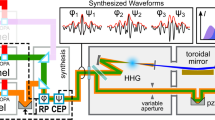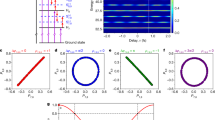Abstract
High harmonic radiation, produced when intense laser pulses interact with matter, is composed of a train of attosecond pulses. Individual pulses in this train carry information on ultrafast dynamics that vary from one half-optical-cycle to the next. Here, we demonstrate an all-optical photonic streaking measurement that provides direct experimental access to each attosecond pulse by mapping emission time onto propagation angle. This is achieved by inducing an ultrafast rotation of the instantaneous laser wavefront at the focus. We thus time-resolve attosecond pulse train generation, and hence the dynamics in the nonlinear medium itself. We apply photonic streaking to harmonic generation in gases and directly observe, for the first time, the influence of non-adiabatic electron dynamics and plasma formation on the generated attosecond pulse train. These experimental and numerical results also provide the first evidence of the generation of attosecond lighthouses in gases, which constitute ideal sources for attosecond pump–probe spectroscopy.
This is a preview of subscription content, access via your institution
Access options
Subscribe to this journal
Receive 12 print issues and online access
$209.00 per year
only $17.42 per issue
Buy this article
- Purchase on Springer Link
- Instant access to full article PDF
Prices may be subject to local taxes which are calculated during checkout




Similar content being viewed by others
References
Corkum, P. B. Plasma perspective on strong field multiphoton ionization. Phys. Rev. Lett. 71, 1994–1997 (1993).
Itatani, J. et al. Tomographic imaging of molecular orbitals. Nature 432, 867–871 (2004).
Wörner, H. J. et al. Conical intersection dynamics in NO2 probed by homodyne high-harmonic spectroscopy. Science 334, 208–212 (2011).
Antoine, P., L'Huillier, A. & Lewenstein, M. Attosecond pulse trains using high-order harmonics. Phys. Rev. Lett. 77, 1234–1237 (1996).
Paul, P. M. et al. Observation of a train of attosecond pulses from high harmonic generation. Science 292, 1689–1692 (2001).
Niikura, H. et al. Sub-laser-cycle electron pulses for probing molecular dynamics. Nature 417, 917–922 (2002).
Baker, S. et al. Probing proton dynamics in molecules on an attosecond time scale. Science 312, 424–427 (2006).
Vincenti, H. & Quéré, F. Attosecond lighthouses: how to use spatiotemporally coupled light fields to generate isolated attosecond pulses. Phys. Rev. Lett. 108, 113904 (2012).
Wheeler, J. A. et al. Attosecond lighthouses from plasma mirrors. Nature Photon. 6, 829–833 (2012).
Akturk, S., Gu, X., Gabolde, P. & Trebino, R. The general theory of first-order spatio-temporal distortions of Gaussian pulses and beams. Opt. Express 13, 8642–8661 (2005).
Krausz, F. & Ivanov, M. Y. Attosecond physics. Rev. Mod. Phys. 81, 163–234 (2009).
Haworth, C. et al. Half-cycle cutoffs in harmonic spectra and robust carrier-envelope phase retrieval. Nature Phys. 3, 52–57 (2006).
Kim, K. T., Ko, D. H., Park, J. J., Tosa, V. & Nam, C. H. Complete temporal reconstruction of attosecond high-harmonic pulse trains. New J. Phys. 12, 083019 (2010).
Lewenstein, M., Balcou, P., Ivanov, M. Y., L'Huillier, A. & Corkum, P. B. Theory of high-harmonic generation by low-frequency laser fields. Phys. Rev. A 49, 2117–2132 (1994).
Chini, M., Wang, H., Khan, S. D., Chen, S. & Chang, Z. Retrieval of satellite pulses of single isolated attosecond pulses. Appl. Phys. Lett. 94, 161112 (2009).
Shin, H. J., Lee, D. G., Cha, Y. H., Hong, K. H. & Nam, C. H. Generation of nonadiabatic blueshift of high harmonics in an intense femtosecond laser field. Phys. Rev. Lett. 83, 2544–2547 (1999).
Varjú, K. et al. Reconstruction of attosecond pulse trains using an adiabatic phase expansion. Phys. Rev. Lett. 95, 243901 (2005).
Christov, I. P., Murnane, M. M. & Kapteyn, H. C. High-harmonic generation of attosecond pulses in the ‘single-cycle’ regime. Phys. Rev. Lett. 78, 1251–1254 (1997).
Kim, K. T., Kim, C. M., Baik, M. G., Umesh, G. & Nam, C. H. Single sub-50-attosecond pulse generation from chirp-compensated harmonic radiation using material dispersion. Phys. Rev. A 69, 051805 (2004).
Abel, M. et al. Isolated attosecond pulses from ionization gating of high-harmonic emission. Chem. Phys. 366, 9–14 (2009).
Ferrari, F. et al. High-energy isolated attosecond pulses generated by above-saturation few-cycle fields. Nature Photon. 4, 875–879 (2010).
Popmintchev, T. et al. Bright coherent ultrahigh harmonics in the keV X-ray regime from mid-infrared femtosecond lasers. Science 336, 1287–1291 (2012).
Sansone, G., Poletto, L. & Nisoli, M. High-energy attosecond light sources. Nature Photon. 5, 655–663 (2011).
Geissler, M., Tempea, G. & Brabec, T. Phase-matched high-order harmonic generation in the nonadiabatic limit. Phys. Rev. A 62, 033817 (2000).
Tempea, G., Geissler, M., Schnürer, M. & Brabec, T. Self-phase-matched high harmonic generation. Phys. Rev. Lett. 84, 4329–4332 (2000).
Frumker, E. et al. Oriented rotational wave-packet dynamics studies via high harmonic generation. Phys. Rev. Lett. 109, 113901 (2012).
Goulielmakis, E. et al. Single-cycle nonlinear optics. Science 320, 1614–1617 (2008).
Sansone, G. et al. Isolated single-cycle attosecond pulses. Science 314, 443–446 (2006).
Mashiko, H. et al. Double optical gating of high-order harmonic generation with carrier-envelope phase stabilized lasers. Phys. Rev. Lett. 100, 103906 (2008).
Goulielmakis, E. et al. Real-time observation of valence electron motion. Nature 466, 739–743 (2010).
Acknowledgements
The authors acknowledge funding from the Natural Sciences and Engineering Research Council, the Air Force Office of Scientific Research and the National Research Council–Commissariat à l'énergie atomique et aux énergies renouvelables agreement. F.Q. acknowledges support from the European Research Council (ERC grant agreement no. 240013).
Author information
Authors and Affiliations
Contributions
K.T.K., D.M.V., P.B.C. and F.Q. conceived the idea and designed the experiment. K.T.K., C.Z., T.R. and J.-F.H. performed the experiment and collected the data. K.T.K. and T.A. provided the numerical analysis. All authors contributed in analysing the experimental data and writing the manuscript.
Corresponding authors
Ethics declarations
Competing interests
The authors declare no competing financial interests.
Supplementary information
Supplementary information
Supplementary information (PDF 1202 kb)
Supplementary Movie
Supplementary Movie (AVI 13223 kb)
Rights and permissions
About this article
Cite this article
Kim, K., Zhang, C., Ruchon, T. et al. Photonic streaking of attosecond pulse trains. Nature Photon 7, 651–656 (2013). https://doi.org/10.1038/nphoton.2013.170
Received:
Accepted:
Published:
Issue Date:
DOI: https://doi.org/10.1038/nphoton.2013.170
This article is cited by
-
Real-time ultrafast oscilloscope with a relativistic electron bunch train
Nature Communications (2021)
-
Attosecond science based on high harmonic generation from gases and solids
Nature Communications (2020)
-
Attosecond streaking using a rescattered electron in an intense laser field
Scientific Reports (2020)
-
Coherent extreme-ultraviolet emission generated through frustrated tunnelling ionization
Nature Photonics (2018)
-
53-attosecond X-ray pulses reach the carbon K-edge
Nature Communications (2017)



